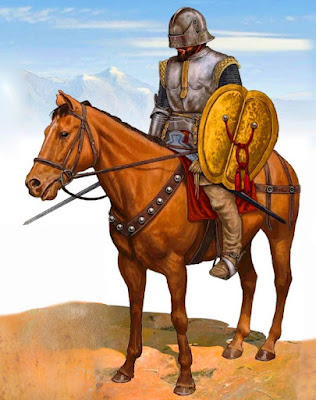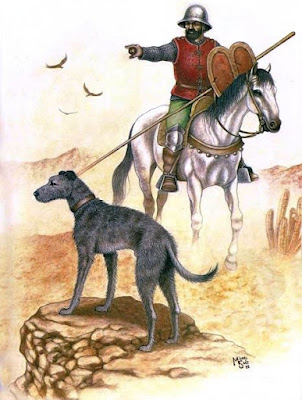My 6th diorama from 2023 depicts the defeat of
the Portuguese explorer Ferdinand Magellan and his crew.
Ferdinand Magellan
organized and launched the first expedition to circumnavigate the
globe, from 1519 to 1522. The expedition consisted of 5 ships:
Trinidad, San Antonio, Concepción, Santiago and lastly Victoria - the only
ship which completed the journey and made it back to Spain, under the
command of Juan Sebastián Elcano.
The crew numbered
around 270 men, mainly Spaniards, but also 40 Portuguese. Members of
other nations were also recorded, including 29 Italians, 17 French,
and a smaller number of Flemish, Greek, Irish, English, Asian, and
black sailors. Counted among the Spanish crew members were at least
29 Basques (including Juan Sebastián Elcano), some of whom did not
speak Spanish fluently.
In 1521 Magellan reached portions of
the Philippine islands, which he named the ''Islas de San Lazaro'' and
claimed for the Spanish crown and promptly got involved in the
rivalries of local chieftains. He had managed to secure the
allegiance or submission of these chiefs, the most important being Rajah Humabon of Cebu.
One chief did not submit: Lapu Lapu.
The battle of Mactan took place in the
archipelago of the Philippines on April 27, 1521. The indigenous
warriors under the chieftain Lapu Lapu overpowered and killed
Magellan and 8 of his men. The small Spanish force, retreated in
disordered panic to the ships and left the islands.
Thanks to the Italian
chronicler Antonio Pigafetta's eyewitness account, the events of the
battle have been preserved. Magellan fervently believed that
his men were so superior to the natives that he only deployed 49 of his crew to face
off against a force of 1,500 enraged natives. He was so confident that he refused the
help of his allies, Rajah Humabon and Datu Zula, and asked them to
just observe the battle.
According to Pigafetta, they arrived at
the distant shores of Mactan three hours before sunrise. Magellan
sent a message to the natives saying that if they still refused to
recognize the Spanish king and pay them tribute, they would
demonstrate how effective their swords and armour were.
The boats of the Europeans were unable
to approach the shore, supposedly because of rocks or corals in the
water, which also prevented the large ships from supporting Magellan
with their artillery. When the sun rose in the morning Magellan and
his men left their boats, leaving 11 men behind. They had to wade
"three crossbow flights" with water up to their thighs
before they could reach the shore.
Magellan divided his small force into
two and ordered his men to engage the local warriors with their arquebuses and crossbows.
However, the missiles had little appreciable effect since the local
fighters were at the extreme range of the Europeans' projectiles.
Furthermore, Lapu Lapu's warriors dodged the bullets and crossbow
bolts with great dexterity. Apparently, the shields of the warriors
of Mactan were made of light materials and were easily pierced by the
European missiles, but this had no effect on the warrior wielding the
shield. Despite his best efforts, Magellan was unable to stop his men
from wasting their bullets and gunpowder, and the Europeans kept up
their missile fire for almost half an hour. In response, Lapu Lapu's
warriors subjected the Europeans to a heavy and demoralizing barrage
of arrows, spears, fire-hardened sticks, and even stones.
Magellan was hit by an arrow and called
for an orderly withdrawal. Though his men were so shaken and
demoralized that they beat a hasty and undisciplined retreat,
abandoning Magellan with just 6 or 8 men. Magellan tried to
cover his army's retreat with his remaining men.
Antonio Pigaffeta recounts:
''When they saw us, they charged
down upon us with exceeding loud cries, two divisions on our flanks
and the other on our front.
The natives shot only at our legs,
for the latter were bare; and so many were the spears and stones that
they hurled at us, that we could offer no resistance. We continued to
retire from the shore always fighting up to our knees in the water.
The natives continued to pursue us, and picking up the same spear
four or six times, hurled it at us again and again.
One of them wounded Magellan on the
left leg with a large cutlass, which resembles a scimitar, only being
larger. That caused the captain to fall face downward, when
immediately they rushed upon him with iron and bamboo spears and with
their cutlasses, until they killed our mirror, our light, our
comfort, and our true guide.''
------------------------------------------------------------------------------------------------------------------------------
Many different brands of miniatures has
been used for this diorama. Bits and pieces from TAG, Steelfist,
Perry, Warlord Games, Artizan Designs, Wargames Atlantic and 1st
Corps.
Since
there are no Philippine warriors available on the market, I had to
create them myself. I used Zulu warrior bits from Perry and Warlords
Games, combining them with 1st Corps Burmese/Thai warriors and some
Sudanese Tribesmen, also from Perry miniatures.
In the end are some
inspirational pictures.
Youtube video: https://www.youtube.com/watch?v=uZKV6b935NQ
 |
| Art by Marek Szyszko. |
|
 |
Art by Oliver Frey.
|
 |
| Art by Neil C. Defeo. |



















































































